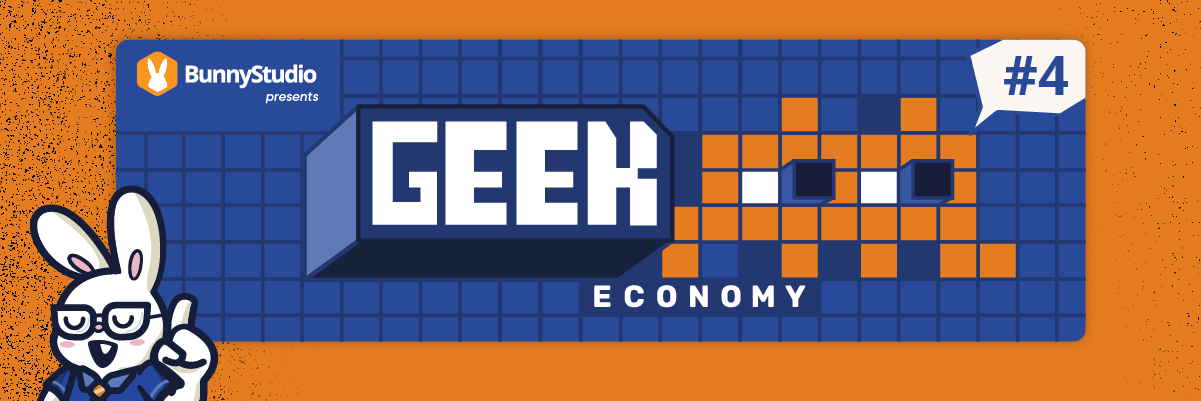— PROLOGUE —
Kristen:
Right now could be the best time in history to be a fan of animation. There’re so many shows being made – from Steven Universe to Bojack Horseman, to indie hits like Hazbin Hotel. They’ve made me laugh, cry, and think deeply about our world.
If you’re like me and you love animation, you’ll know it’s a genre with endless potential. The medium that animators work with is the blank page; possibilities limited only by imagination. In other words: anything is possible. And yet, sometimes, animation is boring.
Year after year, we see the same tired formats, sequel after sequel after sequel. Even worse, animated shows often fail to represent the incredible diversity of the world we live in.
The animation industry is tough – no question. And we’ll get to why that is. But also in this episode, we’ll share how remote work, gig economy platforms, and digital workflows are making it easier than ever to take risks and make amazing content.
— INTRO —
Hey! I’m Kristen Di Mercurio. Lately, so much of our work has gone online. So I’ve been thinking about freelancing, marketplaces, and the future of work.
That’s what our new show, Geek Economy will help you understand. We’ll also show you how the gig economy moving forward, is going to change our lives and our culture.
I would say I know a thing or two about this industry. I’m a professional actress, singer, voice over artist, and I’ve been in my fair share of podcasts.
As an actress, I’ve had all kinds of survival jobs. I’ve worked for taskrabbit, postmates, event staffing, and temp agencies.
Basically, in my world, getting the next gig is the name of the game. As more jobs go online Geek Economy will help guide you through. We’ll explore freelancing, marketplaces, and the future of work. We’ll also show you how the gig economy will change our lives and our culture.
Geek Economy is brought to you by Bunny Studio. Trusted by more than 50,000 companies every year, Bunny Studio helps businesses scale their creative needs with a vetted crowd of freelancers.
— ACT ONE —
Kristen:
We all know that media plays an important role in our lives and our society. But with animation, that’s especially true.
Think back to the cartoons you watched when you were a kid, when your brain was a sponge and your eyes were opened to the world, and you’ll know exactly what I’m talking about.
Angela:
I would come back from school and, basically, you would turn the TV on, we would only have like a couple of channels. And, at that specific time, there was always anime and cartoons running on Colombian television.
So it was like these classics that you would always see in the nineties like Sailor Moon, Dragon Ball, we were also, like, into Gundam and, well, I just got very, very mesmerized by it.
Mat:
It really started out as a love for Disney, and then from there, I was very much fascinated with the behind-the-scenes of just making movies in general.
Luke:
What was funny about Duck Tales is that I think that just by nature of my age. I was young, that was the first cartoon that I got into where it felt like an adventure. Like, listen, I love Looney Tunes as much as the next guy and the old Mickey cartoons, like the shorts, like where it’s like, we’re hunting Wabbits, like, that’s it, that’s what’s happening, but Duck Tales was like a show. Duck Tales was like, we’re going on an adventure. This is like cinematic.
Kristen:
Regardless of who you are, or where you grew up, your favorite cartoon was something wacky, wild, and irreverent. It’s why one of the industry’s biggest successes was a family of talking ducks… or what about a group of schoolgirls who use the power of the solar system to fight evil? It’s why – 22 years after it first aired – almost every meme on the internet uses a screenshot from an episode of SpongeBob SquarePants…
Angela:
When you’re a kid, you are a lot into fantasy and you already have like this huge creative input in your head and that creativity when you’re a little girl, like It’s very easy to just let it go and let it flow and you would be playing with dolls and you would be playing with things and you would make all of these like huge, amazing, like scenarios in your head. And when you watch that in animation, you could really just like draw into that potential like that it had in your head.
Kristen:
That’s Angela Serrano, she’s Senior Customer Operations Coordinator at Bunny Studio (this show’s sponsor, by the way). She thinks the reason people thought animation was only for kids for so long was because it’s the only medium where people can see their vivid imaginations onscreen.
Angela:
So it’s like pretty much a given why children are into animation and why children like it, it’s because it’s that fantasy that really helps you dive into your creative instincts.
If you’re liking what you hear and you have a minute, please subscribe, rate, and review on whatever app you’re using to listen. We are on Apple Podcast, Spotify, Google Podcasts, Amazon, and more! This helps us get the word out to other people so they can learn a bit more about how important the Gig Economy is for everyone. Thanks for listening.
— ACT TWO —
Kristen:
It’s a paradox of the animation industry. Animation works best when it’s wacky and bold – and at the same time – it’s so so expensive to make.
Here’s something to think about.
If you think of the characters on early animated TV shows, they all had something on their neck. Yogi Bear, and Fred Flintstone, have these big collars and neckties despite being a grizzly bear and a caveman, respectively. And that’s not just a quirk in the character design, there’s a reason for it.
Mat:
And even with, Hanna-Barbera, for example, that’s another one where they started out working for a big studio, like MGM, where they started to really become prolific, doing the Tom and Jerry cartoons.
Kristen:
That’s Mat Brunet. He’s a voiceover artist based in Montreal, Canada. If you look him up on YouTube you’ll find these really detailed videos about the history of the animation industry, so we knew we had to talk to him for this episode.
Mat:
But then, suddenly there was a major shift in animation and in entertainment altogether when television occurred and suddenly movie theaters were no longer accepting, uh, stuff like, little cartoons to put on with the movies. And so, Hanna-Barbera would go and move towards television and make their own programs there.
Kristen:
But when Hanna-Barbera switched to television, they found themselves in this tricky spot where they were given less money to make longer cartoons. One of the tricks they developed to cope, was the ‘yogi bear collar’.
They wanted to make it so that when characters talked, their bodies didn’t move, to reduce time, and reduce costs, of course. But they noticed that if your head moves independently of your body, it can look really strange and unnatural. This is why all of their characters, from Yogi Bear to Fred Flintstone, Scooby-Doo, George Jetson, Velma, Daphne, and Fred, either had no neck or had something to visually separate their head from their body, like a collar, a scarf a necktie, or a bowtie. This would make it less awkward visually when their heads moved but their bodies remained still.
And this is something you still see today. In the Simpsons, for example, think of Homer – with his white-collar, Lisa and Marge both have necklaces.
The point is, the way animation studios save costs throughout their work, it’s not just a part of their processes and workflows, it’s baked into the design of the characters themselves.
When studios and producers invest in an animated movie or TV show, they want to bank on the investment – they want a sure thing. But according to Mat Brunet, that dynamic is often the reason why some programs become stale and monotonous.
Mat:
But that’s the major catch is that it is a risk because the biggest obstacle for any original project to go and face is basically the executives.
Because they’re not really interested in making those. They’re a lot more interested in making franchises. They want to create something that can create more movies and more TV shows. That’s why you would see Nickelodeon be a lot more inclined nowadays to create more different types of SpongeBob programs.
And even with movies, for example, that’s especially a massive case, which is why nowadays you would often see studios create more sequels then original programming, and a great example of this is actually with Pixar where throughout the 2010 decade, you may notice that before, like during the 2000 decade, they may nothing but original stuff, it’s very rare that you would actually find anything that would be a sequel because the last time that they would do it was like Toy Story 2 and literally that’s it. But then the 2010 decade, the grand majority of them are just sequels, like Toy Story 3 and 4, Finding Dory, Incredibles 2.
And literally, I did count throughout the 2010s, they only have four original films such as Brave, Inside Out, The Good Dinosaur, and Coco. That was it.
Kristen:
Mat says the history of this industry is littered with independent visionaries. People who start something deeply personal to them, but then (eventually) get bought up by bigger studios who then turn it into a commercial product.
Mat:
Well, a lot of them actually do branch off from some of the bigger studios, it really is often the story of how many would start off small and they would go and work for bigger studios and then they would go on to grow into their own major studio and this could even go all the way back to the days of Walt Disney himself, where he actually worked for Universal when doing the Oswald, the Lucky Rabbit cartoons.
And then when that didn’t really work out as well as planned, he would go on to make his own studio to create Mickey Mouse. And then, well, the rest is history, you could say. The same can pretty much apply to many of the others as well, where you actually started out with, animators, like, Rudy and Ising, for example, they used to work for Walt Disney back in his early days, and then they, would move, to work for Leon Schlesinger and that’s where they really started out with the Warner Brothers animation.
And that’s when they would accumulate people, such as Tex Avery, Chuck Jones, Friz Freleng, and many, many more.
Kristen:
And that’s been the story… until now.
The last 10 years have seen critical changes to the animation industry. Now it’s easier than ever for passionate creators to afford to take chances on their own work, put it online, and let the market prove why it has legs.
Luke:
And what I recognized is in the actual production environment, that if you try to produce cartoons or TV shows or movies, but especially cartoons the traditional way, there’s just so many inefficiencies.
And even before the pandemic happened, even before lockdown and remote work became like the only work, we were recognizing that, hey, we’ve got some in-house animators, and then we’ve got these external guys, far-flung around the world.
Kristen:
That’s Luke Watson. He’s the founder of ‘Creative Connect’, a new platform to produce animated content. He talked to us about how gig economy platforms are making it easier and cheaper to animate…
Luke:
And these external guys are just like essentially hobbyists that have been, to date, making YouTube videos. They’re really good. They’re really fast. They’re passionate. They’ll either do it for a low price, compared to someone’s sitting in Hollywood, who’s you know, gotta pay his rent in the Los Angeles area. Or sometimes they’ll just do it as a collaborative thing. We found a lot of great collaborations where people are like, oh, yo.
You have Hollywood agents?
Like you’re in Los Angeles?
You have access to the networks?
I want to make shows. I want to make cartoons. Let’s collaborate.
We’ve just been getting so much amazing developments and work and passion out of these people around the world that we said, hey, look, look at this, you know, this untapped resource of this global creative pool, these people that are so far from Hollywood, which is still a gated community, all they can do is, they can create content for social media.
Kristen:
Luke thinks the internet has opened the floodgates to all kinds of new animated content, but the gatekeepers aren’t dead… There’s just a better variety of gatekeepers than ever before.
Luke:
And so another thing that we like to do is, you know, we’re recognizing, okay, look, if we want to make money with these, these shows these properties, these projects, we really do need to go through a TV network or a major streaming network, but.
There’s OTT. Can we launch our own apps? Even if it’s a niche, there’s a lot of existing niche OTT apps. Can we partner with them? Can we piggyback on their audiences? They’re gonna be happier, more grateful for the content and they’re going to be less corporatized to destroy it.
We’re developing a cartoon right now with a really big star in the rap world. He’s got like a major, major song and he’s rising up. He’s got 25 million-plus plays on Spotify every month. And he’s got millions of followers on all the social channels. He gets hundreds of millions of YouTube views.
We can just put this out with him. If we had to, like, we want it to go out to Netflix or Adult Swim or wherever it goes, we do want that. But in the meantime, we can be posting it through him and he will want to because it’s his project, we’re co-developing, co-owning it with him.
And then what happens is that if it really is as good as we all think it is, his fans and hopefully other people will grab onto it and then you get social proof. Where we can validate, quantitatively, we can go to the networks and say, look at these numbers. We didn’t wait for your green light. We gave ourselves the green light, or maybe we snuck through a yellow light, but whatever we did, it’s out there now.
I think that there’s a huge opportunity to demonstrate to those big networks, those big decision-makers, and so I guess the disadvantage to the indie studios and the smaller creators is that you still need that, you still need something. If it’s not the gatekeeper at Netflix, you still need a gatekeeper, that’s maybe the celebrity.
— ACT THREE —
Kristen:
So not only do you have new tools to produce these shows but you’ve also got a whole new market of creators and viewers. And when that happens, you get entirely new types of content no one had thought of before.
Angela:
If you think about the 90s and the early 2000s, if you talked about animation, you would be talking about Toei Animation and you would be talking about Aniplex there, and in Western animation, you would be talking about Hanna-Barbera and Warner Brothers and Disney. But right now there are so many names. Like, you have the studio that is making Hazbin Hotel that is literally just based on virality. Like, they released the key animations and like, a poster and like an image. I remember I watched just like, a poster of Hazbin Hotel and it was crazy.
And I was like, what the hell is Disney working on? Because that was my main thought because the animation and just like the character design and how it looks is so amazing, you would have never thought it was like a couple of people doing this at their homes, or like out of a super small animation studio.
Kristen:
The show Angela’s talking about here is a great example. About a year ago, a relatively small Salvadoran-American animation Youtuber released a pilot episode of her show, ‘Hazbin Hotel’. It was produced by Vivienne Medrano and a small team of dedicated animators, producers, and voice artists from all around the globe, funded entirely by the narrow budget from her Patreon page. In the year since she posted it, it’s received almost 50 million views, gathered an adoring fanbase, and been picked up by A24 Studio.
Angela:
And then you saw the pilot and how viral it became. It was something unprecedented. You cannot find something like that outside of the internet. And without the connections and the super globalization that we have right now, it’s something that would have never happened.
Kristen:
The show went viral because it was remarkable, brilliant writing, and a style of animation that felt fresh but familiar at the same time. But it wasn’t just its unique artistic style that made it cut through. It was a labor of love, and because of that, there were features of the show you just wouldn’t find in a Hollywood production.
Angela:
When you have that big Disney guy on top of you telling you, “no, you cannot do that” and a corporation as big as Disney, like they own half of the media of the world, not just the US. They’re not going to bet on something that is not going to bring profit and with this kind of like smaller studios, and if you see Hazbin Hotel, as the main character is a demon and she is a lesbian and she has her girlfriend and then there’s this nonbinary prostitute character.
Disney will never approve that, and we have to be honest. You know, the backlash that has happened just for them showing a kid, taking the hand of another kid and it’s like, well, they’re never gonna approve that because they don’t want to risk those kinds of things and it’s, to me, that’s stupid because I mean, people exist in the world and these things are happening everywhere, and even just having people of color and women as the main characters in a way that they’re not portrayed as they’re always done. Disney’s not gonna approve of something like Hazbin Hotel.
Kristen:
So for Angela, this new world of animation is an opportunity for not just new forms of content but for the representation of different identities. Identities which previously, a studio might not have been able to see a commercial opportunity in.
Angela:
Like in the voiceover industry, like when I was a little girl, I always wanted to do voiceovers for animation. But of course, when I looked at what it entailed to become like a voice over artist for, I don’t know, Disney or like an anime series, it was basically impossible for me, Colombian that speaks mainly Spanish.
And with how the animation industry has become more global, there are a lot of other crafts that are going to start to get more global and the possibilities are, getting too much for people around the world.
For example, I believe that the voice actor for Hazbin Hotel, she had dubbed before, but not for huge productions and yet she got it for Hazbin Hotel and it was amazing.
So it really gives a lot of perspectives and it gives hope to people that would like to see themselves represented or would like to follow that career path to be able to do that. Before it was like, no, I have to be born in the United States and be able to afford to live in California, Los Angeles, and go to a million auditions to even think about becoming a voiceover artist for like, I don’t know, a Disney movie.
Though of course there are a lot of things that you have to study, you would have to do. The possibilities that, I can participate in an animated series that can be watched all over the world and that can become viral like those borders that existed before, around that, just don’t exist anymore.
— OUTRO —
Thanks for listening to Geek Economy: The show that helps you understand how the gig economy is changing our lives and our culture.
Geek Economy is brought to you by Bunny Studio. Trusted by more than 50,000 companies every year, Bunny Studio helps businesses scale their creative needs with a vetted crowd of freelancers.
Find great video creators, voice over artists, designers, writers, and more at bunny studio dot com slash geek economy offer. The link is on the show notes.
If you liked this episode, please share this with someone that would find this of interest. And while you’re at it don’t forget to subscribe, rate, and review on whatever app you use to listen.
Enjoy the show? It’d mean the world to us if you follow us on Podcast on Spotify, or your preferred app!
Credits
This episode was produced in collaboration with Bunny Studio and Pod Paste in Sydney, Australia.
- Executive Produced by Daren Lake
- Written and Produced by Aidan Molins
- Audio Production, Sound Design, and Engineering by Aemyn Connolly
- Podcast management by Michelle Le
- Supervising Editor – Mike Williams
- Assistant Storywriter – Charles Montano
You can check out all of our amazing guests online who helped make this episode great:
- Angela Serrano, Senior Customer Operations Coordinator at Bunny Studio
- Luke Watson, founder of Creative x Connect
- Mat Brunet, voiceover artist













